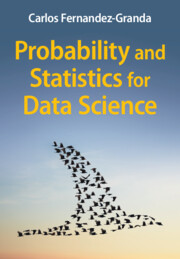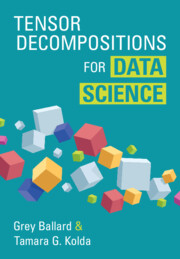Refine search
Actions for selected content:
1835 results in Knowledge Management, Databases and Data Mining
Preface
-
- Book:
- Tensor Decompositions for Data Science
- Published online:
- 05 June 2025
- Print publication:
- 26 June 2025, pp xiii-xviii
-
- Chapter
- Export citation
15 - Generalized CP Decomposition
- from Part III - CP Decomposition
-
- Book:
- Tensor Decompositions for Data Science
- Published online:
- 05 June 2025
- Print publication:
- 26 June 2025, pp 257-272
-
- Chapter
- Export citation
9 - Canonical Polyadic Decomposition
- from Part III - CP Decomposition
-
- Book:
- Tensor Decompositions for Data Science
- Published online:
- 05 June 2025
- Print publication:
- 26 June 2025, pp 157-180
-
- Chapter
- Export citation
Part III - CP Decomposition
-
- Book:
- Tensor Decompositions for Data Science
- Published online:
- 05 June 2025
- Print publication:
- 26 June 2025, pp 155-156
-
- Chapter
- Export citation
4 - Tucker Decomposition
- from Part II - Tucker Decomposition
-
- Book:
- Tensor Decompositions for Data Science
- Published online:
- 05 June 2025
- Print publication:
- 26 June 2025, pp 91-102
-
- Chapter
- Export citation
Index
-
- Book:
- Tensor Decompositions for Data Science
- Published online:
- 05 June 2025
- Print publication:
- 26 June 2025, pp 401-404
-
- Chapter
- Export citation
1 - Tensors and Their Subparts
- from Part I - Tensor Basics
-
- Book:
- Tensor Decompositions for Data Science
- Published online:
- 05 June 2025
- Print publication:
- 26 June 2025, pp 3-20
-
- Chapter
-
- You have access
- Export citation
2 - Indexing and Reshaping Tensors
- from Part I - Tensor Basics
-
- Book:
- Tensor Decompositions for Data Science
- Published online:
- 05 June 2025
- Print publication:
- 26 June 2025, pp 21-46
-
- Chapter
- Export citation
13 - CP Nonlinear Least Squares Optimization
- from Part III - CP Decomposition
-
- Book:
- Tensor Decompositions for Data Science
- Published online:
- 05 June 2025
- Print publication:
- 26 June 2025, pp 233-244
-
- Chapter
- Export citation
16 - CP Tensor Rank and Special Topics
- from Part III - CP Decomposition
-
- Book:
- Tensor Decompositions for Data Science
- Published online:
- 05 June 2025
- Print publication:
- 26 June 2025, pp 273-298
-
- Chapter
- Export citation
Contents
-
- Book:
- Tensor Decompositions for Data Science
- Published online:
- 05 June 2025
- Print publication:
- 26 June 2025, pp v-xii
-
- Chapter
- Export citation
C - Statistics and Probability
- from Appendices
-
- Book:
- Tensor Decompositions for Data Science
- Published online:
- 05 June 2025
- Print publication:
- 26 June 2025, pp 379-388
-
- Chapter
- Export citation

Probability and Statistics for Data Science
-
- Published online:
- 19 June 2025
- Print publication:
- 03 July 2025

Tensor Decompositions for Data Science
-
- Published online:
- 05 June 2025
- Print publication:
- 26 June 2025
7 - Evaluation in Recommender Systems
-
- Book:
- Deep Learning Recommender Systems
- Published online:
- 08 May 2025
- Print publication:
- 22 May 2025, pp 225-247
-
- Chapter
- Export citation
3 - Top of the Tide
-
- Book:
- Deep Learning Recommender Systems
- Published online:
- 08 May 2025
- Print publication:
- 22 May 2025, pp 48-116
-
- Chapter
- Export citation
Afterword
-
- Book:
- Deep Learning Recommender Systems
- Published online:
- 08 May 2025
- Print publication:
- 22 May 2025, pp 291-291
-
- Chapter
- Export citation
8 - Frontier Practice of Deep Learning Recommender Systems
-
- Book:
- Deep Learning Recommender Systems
- Published online:
- 08 May 2025
- Print publication:
- 22 May 2025, pp 248-282
-
- Chapter
- Export citation
9 - Build Your Own Recommender Systems Knowledge Framework
-
- Book:
- Deep Learning Recommender Systems
- Published online:
- 08 May 2025
- Print publication:
- 22 May 2025, pp 283-290
-
- Chapter
- Export citation
4 - Application of Embedding Technology in Recommender Systems
-
- Book:
- Deep Learning Recommender Systems
- Published online:
- 08 May 2025
- Print publication:
- 22 May 2025, pp 117-142
-
- Chapter
- Export citation
